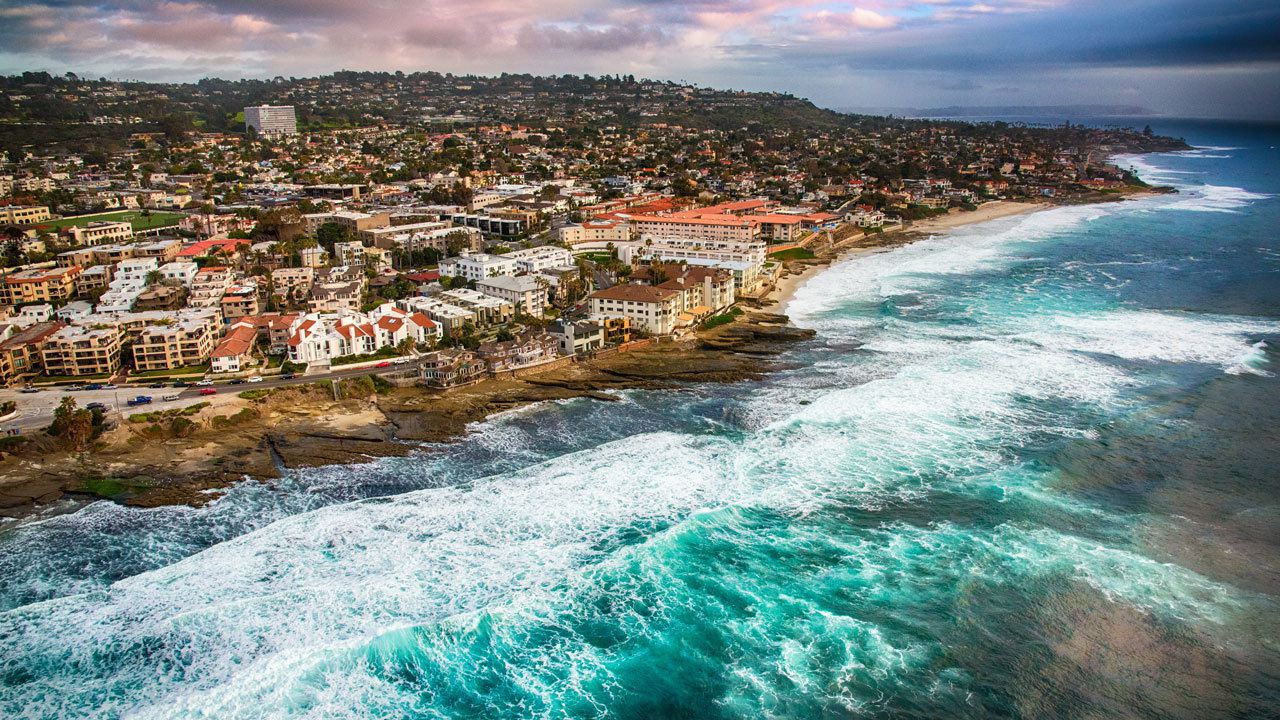With a dramatic coastline boasting incredible views, it's no surprise that La Jolla is one of the most popular beach destinations in California. Surrounded on three sides by the sea and backed by the steep slopes of Mt. Soledad, La Jolla's natural beauty, abundance of activities and upscale village lifestyle ensure that it lives up to its nickname as "the jewel" of San Diego.
La Jolla is a hilly, seaside community within the city of San Diego, California, occupying 7 miles (11 km) of curving coastline along the Pacific Ocean within the northern city limits. The population reported in the 2010 census was 46,781.
La Jolla is surrounded on three sides by ocean bluffs and beaches and is located 12 miles (19 km) north of Downtown San Diego and 40 miles (64 km) south of Orange County. The climate is mild, with an average daily temperature of 70.5 °F (21.4 °C).
La Jolla is home to many educational institutions and a variety of businesses in the areas of lodging, dining, shopping, software, finance, real estate, bioengineering, medical practice and scientific research. The University of California San Diego (UCSD) is located in La Jolla, as are the Salk Institute, Scripps Institution of Oceanography (part of UCSD), Scripps Research Institute, and the headquarters of National University (though its academic campuses are elsewhere).
La Jolla offers a wide range of accommodations from luxurious hotels to casual coastal retreats, along with museums and art galleries, one-of-a-kind boutiques, great restaurants and a slew of outdoor activities. Home to the famous Torrey Pines Golf Course and The Lodge at Torrey Pines, the scenic cliff area offers well-groomed hiking trails with spectacular views, and world-class golf. At Torrey Pines Gliderport you can soar out over the beach cliffs on a hang glider or just relax and watch the action above.
Along the dramatic coastline lies Scripps Park, where families can picnic throughout the summer, while enjoying Fourth of July fireworks and concerts under the stars. Just south of the park is the Children’s Pool, where a seawall was originally built to protect kids from incoming waves, but has been long taken over by a local seal colony. People are no longer permitted to swim here, but you can walk out along the seawall for a close-up view of the wildlife.
La Jolla is also home to Birch Aquarium at Scripps Institute of Oceanography and plenty of cultural attractions including the La Jolla Playhouse and the Museum of Contemporary Art, all situated in close proximity to The Village. The University of California San Diego, which hosts the popular Geisel Library and the Salk Institute for Biological Studies, are both located in La Jolla as well.
La Jolla's biggest draw for locals and visitors alike are the beautiful beaches. During the summer and autumn months, the surf is relatively gentle, with warm waters in 70s. Swimmers, snorkelers, scuba divers, kayakers and surfers can enjoy the golden sands of La Jolla Shores, the Cove and Windansea. And be sure to keep an eye out for migrating whales off the coast as they travel to and from Baja California.
According to United States Census Bureau figures, the ethnic/racial makeup of La Jolla is 82.5% White, 0.8% Black, 0.2% American Indian, 11.2% Asian, 0.1% Pacific Islander, 2.0% some other race, and 3.1% two or more races. Latinos, who may be of any race, form 7.2% of La Jolla's population.
Local Native Americans, the Kumeyaay, called this location mat kulaaxuuy (IPA: [mat kəlaːxuːj]), lit. "land of holes". The topographic feature that gave rise to the name "holes" is uncertain; it probably refers to sea-level caves located on the north-facing bluffs, which are visible from La Jolla Shores. It is suggested that the Kumeyaay name for the area was transcribed by the Spanish settlers as La Jolla. An alternative, pseudo-etymological suggestion for the origin of the name is that it is an alternate spelling of the Spanish word la joya, which means "the jewel". Despite being disputed by scholars, this derivation of the name has been widely cited in popular culture. This supposed origin gave rise to the nickname "Jewel City".
Early history
During the Mexican period of San Diego's history, La Jolla was mapped as pueblo land and contained about 60 lots. When California became a state in 1850, the La Jolla area was incorporated as part of the chartered City of San Diego. In 1870, Charles Dean acquired several of the pueblo lots and subdivided them into an area that became known as La Jolla Park. Dean was unable to develop the land and left San Diego in 1881. A real estate boom in the 1880s led speculators Frank T. Botsford and George W. Heald to further develop the sparsely settled area.
In the 1890s, the San Diego, Pacific Beach, and La Jolla Railway was built, connecting La Jolla to the rest of San Diego. La Jolla became known as a resort area. To attract visitors to the beach, the railway built facilities such as a bath house and a dance pavilion. Visitors were housed in small cottages and bungalows above La Jolla Cove, as well as a temporary tent city erected every summer. Two of the cottages that were built in 1894 still exist: the "Red Roost" and the "Red Rest", also known as the "Neptune and Cove Tea Room"; the two cottages have been vacant since the 1980s, and are covered in tarpaulins. The La Jolla Park Hotel opened in 1893. The Hotel Cabrillo was built in 1908, was later incorporated into the La Valencia Hotel.
The La Jolla Beach and Yacht Club (later the La Jolla Beach and Tennis Club) was built in 1927.
With a dramatic coastline boasting incredible views, it's no surprise that La Jolla is one of the most popular beach destinations in California. Surrounded on three sides by the sea and backed by the steep slopes of Mt. Soledad, La Jolla's natural beauty, abundance of activities and upscale village lifestyle ensure that it lives up to its nickname as "the jewel" of San Diego.
La Jolla is a hilly, seaside community within the city of San Diego, California, occupying 7 miles (11 km) of curving coastline along the Pacific Ocean within the northern city limits. The population reported in the 2010 census was 46,781.
La Jolla is surrounded on three sides by ocean bluffs and beaches and is located 12 miles (19 km) north of Downtown San Diego and 40 miles (64 km) south of Orange County. The climate is mild, with an average daily temperature of 70.5 °F (21.4 °C).
La Jolla is home to many educational institutions and a variety of businesses in the areas of lodging, dining, shopping, software, finance, real estate, bioengineering, medical practice and scientific research. The University of California San Diego (UCSD) is located in La Jolla, as are the Salk Institute, Scripps Institution of Oceanography (part of UCSD), Scripps Research Institute, and the headquarters of National University (though its academic campuses are elsewhere).
La Jolla offers a wide range of accommodations from luxurious hotels to casual coastal retreats, along with museums and art galleries, one-of-a-kind boutiques, great restaurants and a slew of outdoor activities. Home to the famous Torrey Pines Golf Course and The Lodge at Torrey Pines, the scenic cliff area offers well-groomed hiking trails with spectacular views, and world-class golf. At Torrey Pines Gliderport you can soar out over the beach cliffs on a hang glider or just relax and watch the action above.
Along the dramatic coastline lies Scripps Park, where families can picnic throughout the summer, while enjoying Fourth of July fireworks and concerts under the stars. Just south of the park is the Children’s Pool, where a seawall was originally built to protect kids from incoming waves, but has been long taken over by a local seal colony. People are no longer permitted to swim here, but you can walk out along the seawall for a close-up view of the wildlife.
La Jolla is also home to Birch Aquarium at Scripps Institute of Oceanography and plenty of cultural attractions including the La Jolla Playhouse and the Museum of Contemporary Art, all situated in close proximity to The Village. The University of California San Diego, which hosts the popular Geisel Library and the Salk Institute for Biological Studies, are both located in La Jolla as well.
La Jolla's biggest draw for locals and visitors alike are the beautiful beaches. During the summer and autumn months, the surf is relatively gentle, with warm waters in 70s. Swimmers, snorkelers, scuba divers, kayakers and surfers can enjoy the golden sands of La Jolla Shores, the Cove and Windansea. And be sure to keep an eye out for migrating whales off the coast as they travel to and from Baja California.
According to United States Census Bureau figures, the ethnic/racial makeup of La Jolla is 82.5% White, 0.8% Black, 0.2% American Indian, 11.2% Asian, 0.1% Pacific Islander, 2.0% some other race, and 3.1% two or more races. Latinos, who may be of any race, form 7.2% of La Jolla's population.
Local Native Americans, the Kumeyaay, called this location mat kulaaxuuy (IPA: [mat kəlaːxuːj]), lit. "land of holes". The topographic feature that gave rise to the name "holes" is uncertain; it probably refers to sea-level caves located on the north-facing bluffs, which are visible from La Jolla Shores. It is suggested that the Kumeyaay name for the area was transcribed by the Spanish settlers as La Jolla. An alternative, pseudo-etymological suggestion for the origin of the name is that it is an alternate spelling of the Spanish word la joya, which means "the jewel". Despite being disputed by scholars, this derivation of the name has been widely cited in popular culture. This supposed origin gave rise to the nickname "Jewel City".
Early history
During the Mexican period of San Diego's history, La Jolla was mapped as pueblo land and contained about 60 lots. When California became a state in 1850, the La Jolla area was incorporated as part of the chartered City of San Diego. In 1870, Charles Dean acquired several of the pueblo lots and subdivided them into an area that became known as La Jolla Park. Dean was unable to develop the land and left San Diego in 1881. A real estate boom in the 1880s led speculators Frank T. Botsford and George W. Heald to further develop the sparsely settled area.
In the 1890s, the San Diego, Pacific Beach, and La Jolla Railway was built, connecting La Jolla to the rest of San Diego. La Jolla became known as a resort area. To attract visitors to the beach, the railway built facilities such as a bath house and a dance pavilion. Visitors were housed in small cottages and bungalows above La Jolla Cove, as well as a temporary tent city erected every summer. Two of the cottages that were built in 1894 still exist: the "Red Roost" and the "Red Rest", also known as the "Neptune and Cove Tea Room"; the two cottages have been vacant since the 1980s, and are covered in tarpaulins. The La Jolla Park Hotel opened in 1893. The Hotel Cabrillo was built in 1908, was later incorporated into the La Valencia Hotel.
The La Jolla Beach and Yacht Club (later the La Jolla Beach and Tennis Club) was built in 1927.


